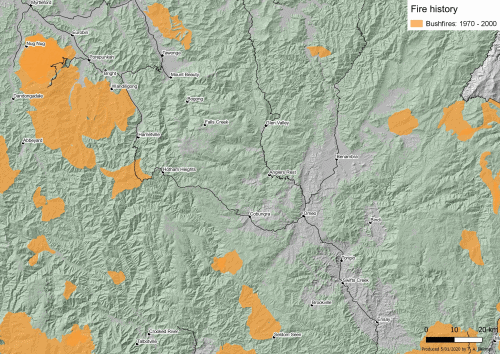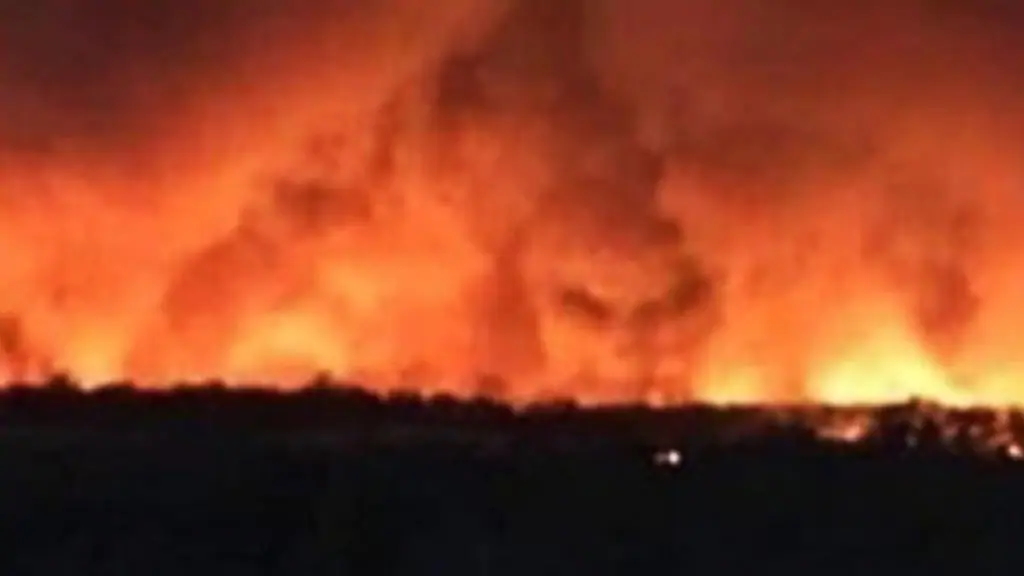Deforestation in Australia killing and mutilating koalas – Loggers say finding dead koalas is “like a daily thing, sometimes a couple every hour”

By Oliver Milman
23 July 2013
(The Guardian) – Revelations of koalas suffering graphic injuries and death in Victorian timber plantations are evidence of a long-standing failure to properly protect the iconic Australian marsupials, according to a leading conservation organisation. Footage on Monday night’s 7.30 report showed koalas, including babies, lying dead on the floor of a cleared forest. One koala was missing an arm while another injured animal relocated to a new area of bush was shown to be in visible distress. The report featured claims that large numbers of koalas are being wiped out in Victoria, in large part due to logging practices in the south-west of the state.
An anonymous timber worker said that finding dead koalas was “like a daily thing. Sometimes a couple every hour. Sometimes just one a day. You’d normally come across them on the ground already dead or pretty badly injured.”
Koalas have moved into the blue gum timber plantation fields due to the dwindling of the animals’ native forest habitat. The marsupials are then killed or seriously crippled when trees are felled by timber contractors, with wildlife volunteers confronted by broken backs, severed limbs and dead mothers with joeys.
Deborah Tabart, the chief executive of the Australian Koala Foundation, told Guardian Australia that public revulsion over the deaths should be aimed at federal and state governments that have failed to safeguard koalas.
“I knew things were bad, but didn’t know they were quite that grim,” she said. “I’ve seen a lot of terrible things happen to koalas, but this is the best ammunition I’ve ever had to get koalas properly protected.
“No one is taking full responsibility for the koala. It’s a native icon but everyone is saying it’s someone else’s job. The government has allowed industry to completely self-regulate. We need a new koala protection act that says you simply can’t touch a tree where a koala lives.”
Tabart said the Victorian government had failed to check that loggers were reducing risks to koalas, while the federal government had erred by not listing the animal as endangered in Victoria.
Last year, then federal environment minister Tony Burke listed the koala as endangered, but only in NSW, Queensland and the ACT.
“I’m angry with Tony Burke for not listing it properly and I have no respect for the Victorian government, which has just asked industry what it’s doing and they’ve said ‘no worries, mate’. It seems that the Victorian government truly believes koalas are pests that require no management at all. There has been massive cruelty to koalas in Victoria over the years,” Tabart added.
Greens senator Lee Rhiannon said that the scale of koala deaths and injuries was “very disturbing”.
“The logging industry urgently needs harvesting protocols to ensure trees are cut with minimum impact on koalas, and koala habitat is protected so healthy populations are easily able to move across the landscape,” she said.
“I call on government ministers to stop regarding koalas as pests and show leadership to provide the protection Australians expect koalas to be given.” [more]
Conservationists accuse governments of failing to protect koalas

By Greg Hoy
22 July 2013
(Australian Broadcasting Corporation) – Timber plantations created as part of now-failing managed investment schemes have become places of refuge for koalas as their natural habitat dwindles but, as the plantations are harvested, the native animals face deadly threats, and a warning that this report contains some graphic images.
Transcript
CHRIS UHLMANN, PRESENTER: As thousands of Australian investors have discovered, ploughing your savings into timber plantations has proven to be a very bad tax refuge. Ironically, those same plantations have turned out to be an alternative refuge for koalas, driven from their dwindling natural habitat. But it’s turning out to be a temporary and dangerous home, as the koalas often suffer serious injury and even death when the timber is harvested. Greg Hoy reports, but first a warning: this report contains some disturbing images.
GREG HOY, REPORTER: This is the cry of a koala in distress. To understand why he and those like him are in distress, 7.30 took a revealing journey across south-west Victoria and into South Australia. Our aim: to find and film large colonies of koalas facing great danger. Their habitat shrinking, they’ve made their homes in vast blue gum timber plantations, which are increasingly being logged. Large numbers of koalas are being wiped out in the process and it’s not a pretty sight.
STEPHEN PHILLIPS, FED. GOVT. KOALA WORKING GROUP: We create a big brouhaha when we see it happening to cattle in a slaughterhouse over in Indonesia or somewhere like that, but this is happening in our own backwards with a much bigger impact. This is an international icon that we’re treating with so much disrespect and disdain.
GREG HOY: It was workers with logging and timber companies worried by what they’d witnessed who blew the whistle, anonymously, for fear of losing their jobs. The koalas that were hurt in the process, what happened to them?
Most of them just stayed out there.
GREG HOY: How often would it happen?
It was pretty – it was like a daily thing. Sometimes a couple every hour. Sometimes just one a day. You’d normally come across them on the ground already dead or pretty badly injured.
TRACEY WILSON, WILDLIFE VOLUNTEER, KOROIT: You’d only get a call for an injured koala if one of the guys on site didn’t think it was right.
GREG HOY: What would they say about the koalas?
Oh, that it wasn’t happening. We weren’t dropping any or they weren’t there.
GREG HOY: They’re there alright, and the casualty rate has been horrendous. Across the centre and south-west of Victoria and in South Australia, we visited many volunteer animal refuges struggling without help from industry or government to cope with casualties.
TRACEY WILSON: Broken limbs, impact wounds, broken backs, severed arm. Dead mothers with joeys that are still alive, trying to survive. I had one 500 gram joey, about this big (demonstrates size with hands) that had two healed broken arms. And so we can only assume from that that the mother had been dropped previous to this incident and she had no obvious breaks, but her intestines were just pulp.
JILL ROWLEY, WILDLIFE VOLUNTEER, MT. GAMBIER: This is Jimmy. He was dropped in a plantation. One of the young blokes that worked on site actually rang me and I went and picked him up. He had a broken leg. He was lucky. His injury was fixable.
GREG HOY: Very rarely, a company calls to get help for injured animals, as happened recently with wildlife rescuer Jill Rowley in Mount Gambier, South Australia.
JILL ROWLEY: I am aware that in that particular location there was 21 koalas killed. 14 of those I actually personally had to euthanize. On a recent plantation, we got 28 out and that includes some of them were dead and some of them were alive. There was an original estimate from one of the workers there that were probably over 50 in that plantation. We’re not sure what’s happened to them.
SHANNON MCKAY, WILDLIFE VOLUNTEER, WARRNAMBOOL: I think 24 animals may have come in from this plantation and it was a fairly small one. So looking at the hectares of plantation in Western Victoria and across into South Australia, I think we’re facing a crisis with these guys.
TRACEY WILSON: It’s a huge issue. That’s why Australians should care. There’s gonna be a lotta koalas killed.
GREG HOY: Well we know that there’s one little creature up here and another one just over there. The question is: how many more are there round here? Well according to the industry’s own guesstimate, there are some 8,000 koalas within a 20-kilometre radius of this plantation. Now this plantation’s proprietor is the American-owned Australian Blue Gum Plantations which claims that it’s seen no incidents of koala deaths or injuries. But others beg to differ.
TRACEY WILSON: It’s garbage. We know it’s happening. We’ve had animals from their plantations. We know it’s happening. It’s denial. That’s all it is. It is happening. And while they continue to say it’s not, really just makes them looks worse, I believe.
GREG HOY: Australian Blue Gum Plantations would not be interviewed. The scale of what the company has at risk is best understood by visiting the port of Portland. Here, the US-owned company and the half-Japanese-owned South West Fibre plan to export 1.2 million tonnes of blue gum logs and woodchip a year to Japan and China for paper production. Both the Chinese and Japanese public have a great affection for the koala, but know nothing of the dark secret that taints their paper production.
JILL ROWLEY: If this gets too public, there’s a lot of fear with the logging companies around that if we talk too much about what’s happening with the koalas, that the industry’ll be brought to a standstill. We’re talking money. They make big money out of this. What’s a dead koala?
GREG HOY: No-one from industry would be interviewed for this program, leaving that to the Victorian Department of Environment and Primary Industry.
ANDREW PRITCHARD, VIC. DEPT OF ENVIRONMENT AND PRIMARY INDUSTRIES: We provide the overall – overarching guidelines about how animals or koalas are s’posed to be handled.
GREG HOY: So do you actually run checks?
ANDREW PRITCHARD: We haven’t previously. We take information that’s been reported through to us and then work through with the industry as we are sitting at the moment.
GREG HOY: So you accept whatever the industry tells you is happening?
ANDREW PRITCHARD: Ah, no, look, we do do some on-ground assessments with industry. So it’s hand in hand, so we’re certainly working with industry, for them to be able to achieve a better outcome than what has certainly happened in the past.
GREG HOY: So no random checks?
ANDREW PRITCHARD: No, no random checks.
TRACEY WILSON: I just don’t see how it’s possible for an industry to self-govern something like that. It sure hasn’t happened to date. Obviously an industry does not want to be exposed for doing the wrong thing. I think some people have been doing it for so long they’re just numb to it. And just – it’s a job, they do it, these things happen.
STEPHEN PHILLIPS: They’re the things that you’ve just gotta have in place, people on the ground to make sure that animals aren’t in trees that are pulled down and pulled through shedders, for example. There’s a compounded problem in Victoria because it’s a very denuded landscape. Forest is contained to sorta small patches across the landscape.
GREG HOY: In the morning mist of Mount Eccles National Park, this should be a happy ending. A koala captured in a log plantation in poor health is released into a small pocket of manna gum. His future, however, looks bleak. The food here is scarce, the competition fierce. Relocated koalas tend to pine for home. The familiar scent of big plantations in the distance will be hard to resist. This could well prove a fatal attraction.
JILL ROWLEY: There simply isn’t anywhere else and this is the nearest habitat and pretty much the only habitat, which is under stress from a population that already exists here.
GREG HOY: So what chance would you give this koala?
JILL ROWLEY: I really don’t know.
CHRIS UHLMANN: Greg Hoy reporting.



Disgusting. Thank you for spreading awareness